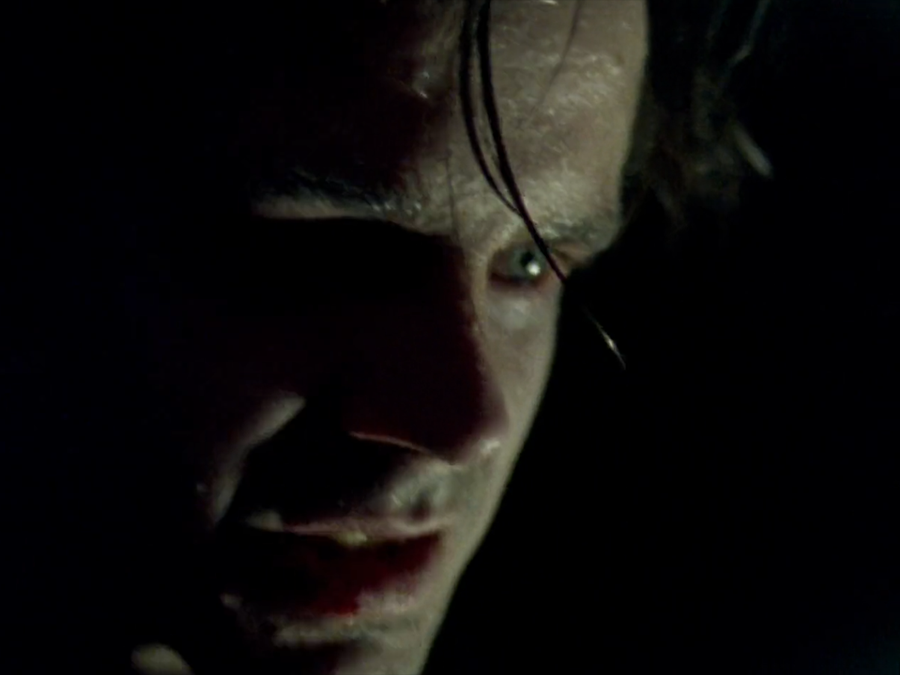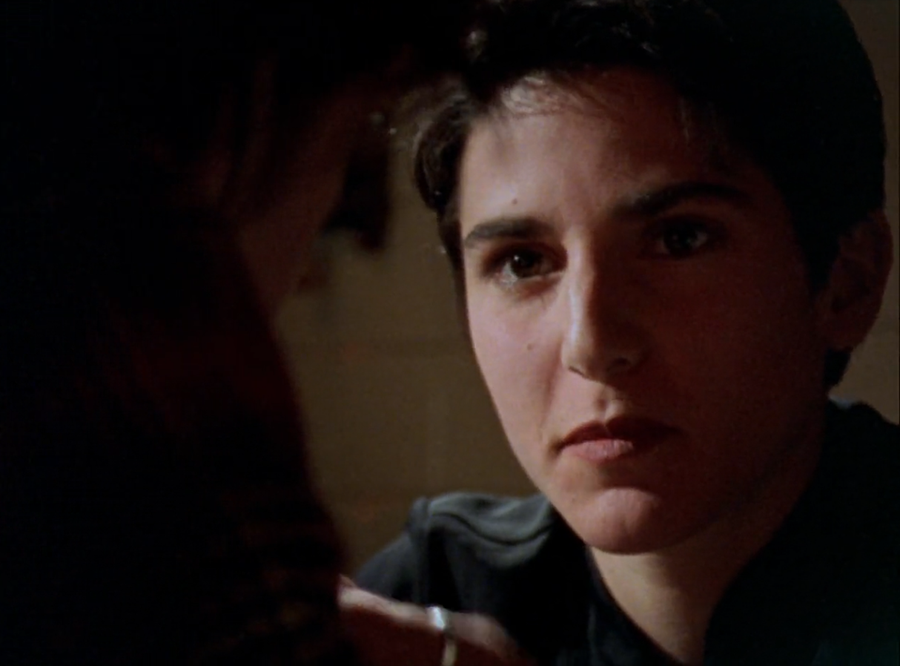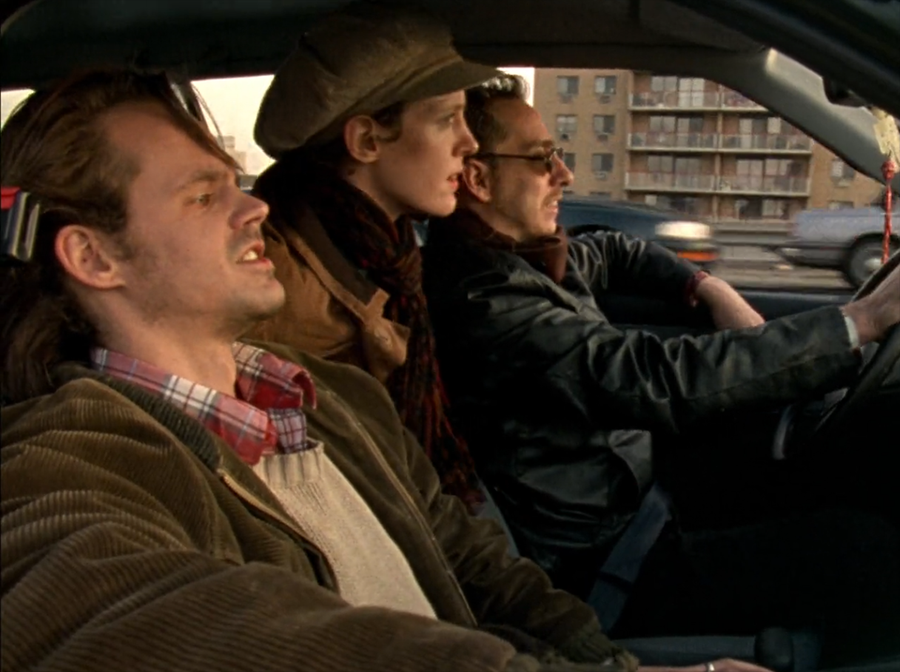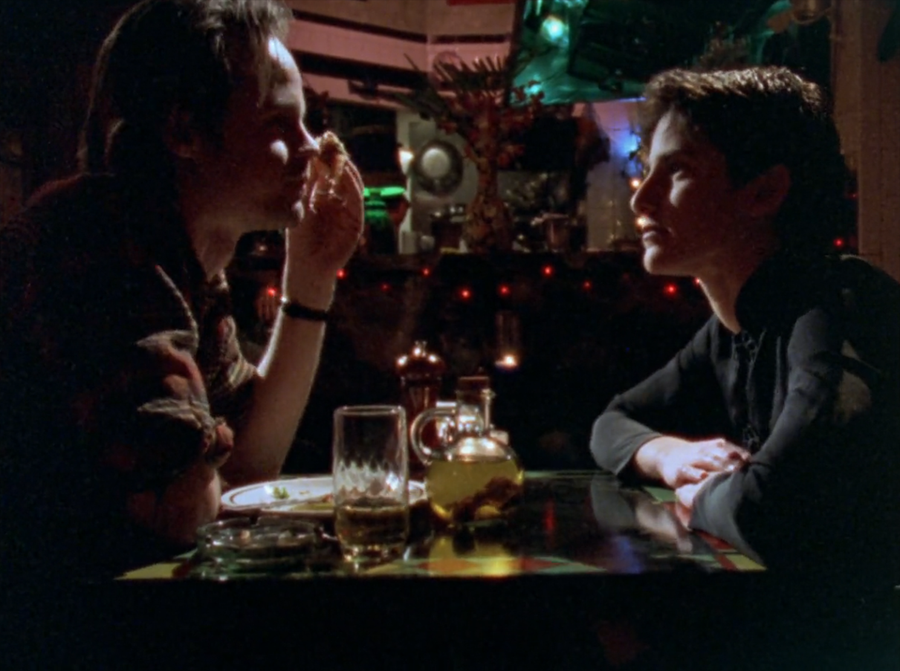HABIT
Directed by Larry Fessenden. 1995. United States.

Sam has been having a rough time lately. His father has recently passed away. Liza, his now ex-girlfriend, is moving out. Still, he always has the bottle. At a Halloween costume party thrown by his best friend, Nick, and his girlfriend, Rae, Sam catches the eye of Anna, an enigmatic woman with a pixie cut and no costume on. Anna doesn’t seem like she belongs here, but neither does Sam. “I'm committing suicide on the installment plan,” he jokes, swaying from side to side like a sailor just returned from the sea. Anna dodges questions, playing coy at every attempt at wringing some personal information out of her, but Sam is clearly smitten. She gives him her number then disappears into the night.
Sam wakes the next day, completely forgetting Anna’s phone number, but not her face. She is all he can think about. Sam helps his ex move into her new place. It is obvious they still care about each other. If not for Sam’s drinking, they would likely still be together. Later that night, Sam runs into Anna at a fair. They pick right up where they left off, sharing a kiss and a ride on the Ferris wheel. The new couple takes a late-night walk in Battery Park. During an intense makeout session, Anna bites a very inebriated Sam on the lip, sucking his blood while jerking him off.
Sam wakes up in the park, alone, his mouth bloody. At work, he finds out that a coworker, Lenny, has gone missing. The last time they talked, Lenny had been in a bad state, weak and shaky, but giddy about meeting a girl. Anna keeps popping up unexpectedly at night, and as their relationship deepens, Sam begins feeling strung out and lightheaded. Worse, he keeps waking up with new wounds on his body. But still, he can not stop thinking about her.

Sam goes to Long Island to spend Thanksgiving with Nick and Rae. Rae is worried about Sam’s deteriorating health and worsening emotional state, but Nick barely notices, his mind in the bottle. Rae puts her foot down. She wants Nick to stop feeding Sam booze, which he does, but only briefly. At last, Anna arrives. At first, Rae finds Anna off-putting and abrasive, but later on, Rae nearly succumbs to her charms, playfully kissing her during a rainstorm. When Sam and Nick wake in the morning, they find a note saying that the girls took the train home.
Sam hits rock bottom, his health in shambles, barely able to think straight. He calls it quits with Anna and tries to reconcile with Liza. Sam begins to believe that there might be a connection between his mysterious wounds, Anna’s playful fascination with blood, and his failing health. He begins to put two and two together. Lenny also met a girl, and just like Lenny, his health is failing rapidly. Is it only a matter of time before he goes missing, too? Maybe Anna is not an ordinary fling. Maybe Sam has been dating a vampire.
Countless people have compared Larry Fessenden’s HABIT with that other vampire film from 1995, Abel Ferrara’s THE ADDICTION, and rightfully so. Both films were shot in New York and use vampirism as an allegory for substance abuse. They make for one hell of a double feature, but THE ADDICTION is not the vampire film I think of when watching HABIT. No, my mind goes straight to George Romero’s 1977 masterpiece, MARTIN.

Economic decay, pervasive feelings of isolation, violence as intimacy, dependency, and compulsion. These are shared traits between HABIT and MARTIN. The atmosphere of both films is oppressive, with their urban settings feeling like rotting, alien landscapes. Both films are filled with people consumed by their pathologies, held hostage by alienation and loneliness. Even sex is reduced to little more than a consumptive ritual, detached from emotional bonds. Faith and human intimacy, saviors for most, cannot help Martin and Sam. Their illnesses will not allow it, and neither man seems capable of doing anything to change that fact about themselves. They are not heroic figures who will overcome. They are purely tragic figures, doomed by their pathology, and all too aware of it.
In HABIT, vampirism is everywhere. It is in the streets, in bottles, in crowds, in toxic relationships. The world is indeed a vampire. Multiple people in the film have relatives who have recently died, relationships that are failing, and friendships built on one-sided interest. No one is happy, no one is content. The world is draining them, changing them into something fragile and distant. Nick plies Sam with booze to keep him passive and engaged, but struggles to connect with him on a human level when Sam needs him the most. Nick doesn't really see Sam as a human being. He is merely a distraction, like a human jukebox. He puts booze in, and noise comes out. Unable to comfort Sam, he tells him to drink up, because for Nick, there is no other solution to the world around him. You get the feeling that all of these people would be happier anywhere else, that they are all making each other’s lives worse simply through proximity.
You may have noticed that I did not mention Anna once in all that gabbing about vampirism. Well, that’s because the film does not really answer the question of whether or not Anna is a bona fide bloodsucker or just another drain on Sam’s tired existence. Fessenden’s films often play with perspective. In THE LAST WINTER, we experience most of the supernatural events from Hoffman’s perspective, which is almost always at odds with the perspectives of his coworkers. While watching a dead man’s video confessional, Hoffman sees a spectral entity emerge from behind the man on the screen. No other member of the team mentions it, almost as if it happened only in Hoffman’s imagination. In WENDIGO, we adopt the perspective of a child dealing with a parent critically wounded in a shooting. It is difficult to imagine where my mind would go in a scenario like that, let alone the mind of a child trying to make sense of that level of trauma. Is the Wendigo real, or is it just the mind of a child imagining a protective entity now that his parents, a child's only source of security, cannot protect him?

Is Anna a vampire? As someone who grew up with a functional alcoholic parent, it was not unusual to spot bruises and scrapes on his arms and legs. He would never know where he got them from because he was too fucked up to remember. Sometimes, he could not recall whole chunks of a day thanks to alcoholic blackouts. There were times when he was physically ill because of drinking too much, his energy drained by the poison, but the dependency was too much, so he would open the refrigerator and grab another bottle. I remember when he found out his father had died. I also remember when he found out my grandmother had passed away. Both times, he didn’t say a word. He just went to the kitchen for a bottle of booze.
Anna is most certainly a real person. She interacts with other characters multiple times, but is Anna always real? Is she a flesh-and-blood vampire, or is she just another toxic companion using Sam for sex and attention the way Sam uses alcohol for relief and escape? You can view HABIT from multiple perspectives, although inarguably, Fessenden gives a far firmer answer here than he does in either WENDIGO or THE LAST WINTER. You might think this noncommittal angle would negatively impact the film's effectiveness, but I assure you, it does not. HABIT is a supremely effective film. Shot on the streets of New York City in the 90s, the film has a verite edge to it, capturing real New Yorkers on their daily commutes, standing in windows, and sleeping on the streets. Most of the performers are amateur actors, with Fessenden himself playing the role of Sam. Every actor is perfect in their role. The only time the performances suffer is when the naturalistic screenplay strays from the more improvisational scenes of conversation and intimate action to ones crammed full of exposition. Those are the only moments in the film that feel false.
Although Fessenden already had a couple of films under his belt, HABIT feels like a first film, a big swing for the fences affair full of tension, brave performances, and documentary flair. It is both intimate and autobiographical, rippling with raw immediacy and blunt honesty. As screenwriter, director, and lead actor, this is Fessenden’s film, through and through, and he is a powerhouse for all 112 minutes. HABIT is an overwhelmingly sad, tragic vampire story that can stand shoulder to shoulder with Romero’s masterwork, and it only gets better the more I watch it.